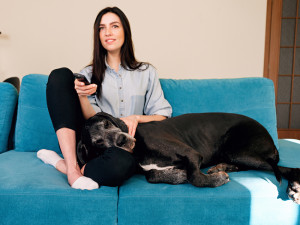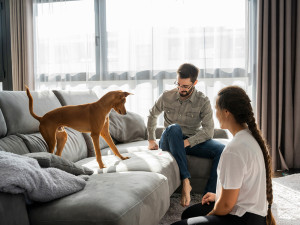Dogs Love to Watch TV, New Study Says—But Should You Let Them?
Time for some screen-time ground rules, pups.

share article
When my kids were young, it made them happy to hear me groan about a looming deadline. They knew from experience they would get to watch movies until the writing gods smiled on me enough to complete whatever I was working on.
For that reason, you’ll never hear any judgment from me about plopping kids in front of screens from time to time — you do what you have to do! That’s why I say, to those holier-than-thou parents out there criticizing screen time for kids, “I’m not interested in your thoughts on the matter, thanks.”
Criticism about screen time is just a part of parenting in the modern world, as is disagreement about how much is too much. If you’re interested in a social experiment, try yelling at a group of parents with any assertion about how much TV time is too much for kids and see all hell break loose while they all descend into unhinged arguments.
Now, it looks like we might get to have the same debate and be shamed for our choices as pet parents — because a January study reveals opens in a new tabthat dogs also love spending time in front of that glowing monitor of endless entertainment.
Dogs love TV.
In the study, over 1,200 people filled out a survey about their dogs and their interest in a variety of activities, such as animals, ball sports, non-ball sports, and vehicles. These same people answered questions about their dogs’ reactions to four videos of movement going across a screen, of a dog, a bird, traffic, and a panther.
Dogs had a lot of different reactions to the videos, according to the surveys. It’s common for dogs to turn their head to the side and prick their ears, to vocalize, or to approach the screen. Over three-quarters of dogs in the study performed each of these behaviors. Over one-quarter of them looked behind the screen or around the side of it or touched the screen with their nose. Just a few (about one in 20) of the dogs brought a toy to the screen or ran away from the screen.
Almost half of the people who participated in the study play videos or leave the TV on for their dogs when they are home alone. Seventeen percent of the people play dog-specific content, like DogTVopens in a new tab, for their dogs. There were nearly as many people who provided screen time for their dogs in their absence (48 percent) as those who provided interactive toysopens in a new tab for their dogs (57 percent), which gives you some idea how popular the strategy is for entertaining dogs.
They really love watching other dogs on the screen.
Just like me when I couldn’t pull away from that long-awaited Ted Lasso series finale, dogs get excited about what's on TV. They pay a lot of attention to screens, especially when animals are in the videos. Unsurprisingly, they are enchanted by dogs most of all. People who filled out the surveys reported that their pups loved the movement on the screen and aren’t as interested in the sound. In fact, a number of the people surveyed in the study reported that their dogs were just as interested in watching activity on screens when the sound was off as when it was on.
Like kids, all dogs are susceptible to getting sucked into movies, videos, and social media, but some may be a bit more than others. Young dogs are more likely to be into watching screens than older dogs. Herding and sporting breeds are most likely to be into screens compared with other groups of dogs. Dogs with good vision were more interested in their screens as well.
Is too much screen time a bad thing for dogs?
Screens can entertain dogs, but it should not get in the way of their other needs, such as being outside, getting lots of exercise, playing, being social, and training time. So, while there’s not a firm rule about how much screen time is too much, it should only be a supplement to making their days interesting. It should not be the main way to stimulate your dog’s brain but is just an additional tool for making their life interesting.
TV can help keep dogs occupied when they are alone, but it’s not going to be effective at treating separation anxiety. And, it’s not going to be stimulating enough to get you off the hook for walks, play time, and teaching them new skills. They need time to be outside and active, with the amount of exercise depending on their age and activity level — so make sure screen time is not cutting into those activities. Too much screen time is bad for dogs if it’s taking away from other quality activities — they really are like little kidsopens in a new tab. Looks like screen-time rules should be implemented for the whole family now.
References:
Screen Interaction Behavior in Companion Dogs: Results From a Dog Owner Surveyopens in a new tab

Karen B. London, PhD, CAAB, CPDT-KA
Karen B. London, Ph.D., is a Certified Applied Animal Behaviorist and Certified Professional Dog Trainer who specializes in working with dogs with serious behavioral issues, including aggression, and has also trained other animals including cats, birds, snakes, and insects. She writes the animal column for the Arizona Daily Sun and is an Adjunct Professor in the Department of Biological Sciences at Northern Arizona University. She is the author of six books about training and behavior, including her most recent, Treat Everyone Like a Dog: How a Dog Trainer’s World View Can Improve Your Lifeopens in a new tab.
Related articles
![A couple int he living room playing with a laser on the couch with their dog]() opens in a new tab
opens in a new tabAre Laser Pointers Bad for Dogs?
Learn why these red beams of light are bad for dogs.
![Young woman looking at cellphone with her dog]() opens in a new tab
opens in a new tabDoes Your Dog Understand When You FaceTime Them?
It’s a nice thought.
![Brown puppy on grey couch watching a smart phone]() opens in a new tab
opens in a new tabNew Phone, Who Dis?
Researchers at the University of Glasgow are testing a “DogPhone” that allows your pet to video-call you. We gave its architect, Dr. Ilyena Hirskyj-Douglas, a ring to hear more.
![A woman wearing a knit sweater holding a dog close on the floor of her bedroom.]() opens in a new tab
opens in a new tabSeparation Anxiety in Dogs
Train your dog to stay calm when they’re on their own — instead of sad-singing “All By Myself” until you come home.
![African American man with braids sitting on his bed using his computer with his dog next to him also looking at the computer]() opens in a new tab
opens in a new tabThere’s a High-Tech Training Solution For Your Dog’s Separation Anxiety
Like most things in 2023, there’s a Zoom link for this.







